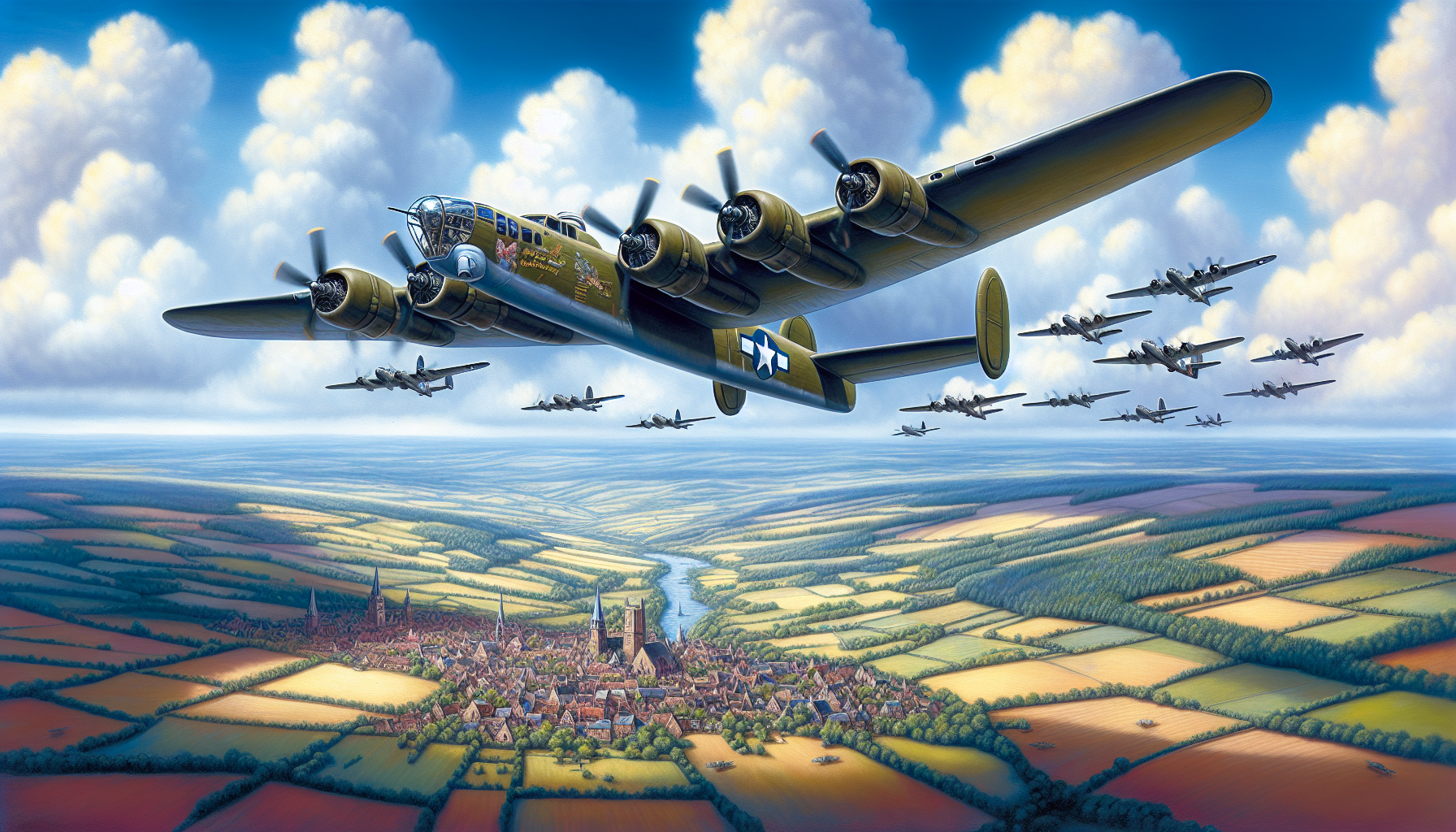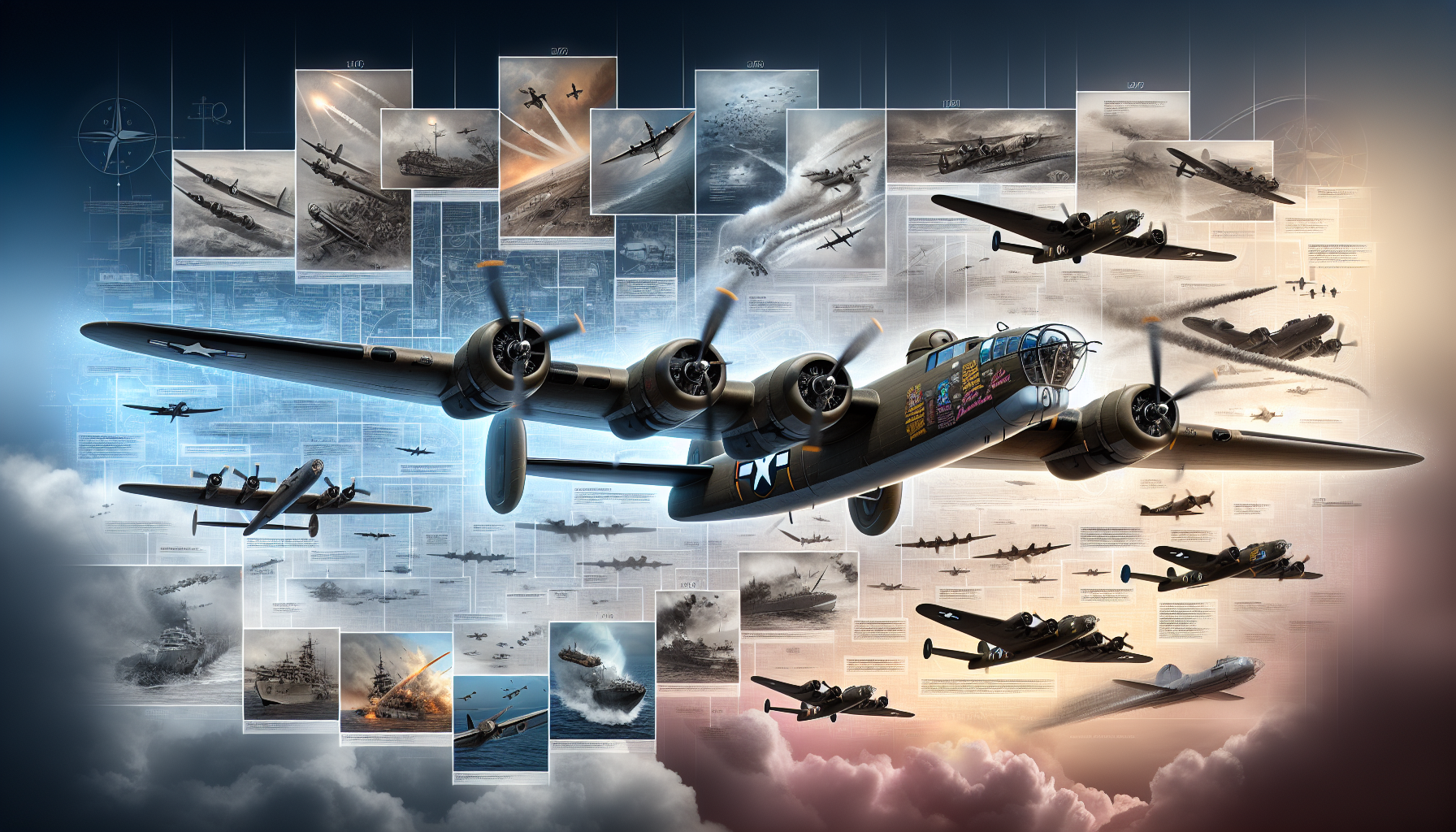B-24 Bomber: The WWII Powerhouse
The B-24 Bomber was a crucial aircraft in World War II, known for its long range and large payload. This versatile bomber played a key role in many missions and innovations in aircraft design. This article delves into the B-24’s development, unique features, operational history, and enduring legacy.
Key Takeaways
-
The B-24 Bomber was developed to surpass the B-17in range, speed, and payload capacity, featuring innovations such as the Davis wing and dual bomb bays.
-
It played a crucial role in World War II across various theaters, including strategic bombing missions in Europe and anti-submarine warfare in the Atlantic, showcasing its versatility and effectiveness.
-
The production of over 18,000 B-24 bombers marked it as the most manufactured bomber in history, significantly contributing to the Allied war effort and influencing future aircraft designs.
Main Types of U.S. Warbirds in WWII
The skies over World War II battlefields were filled with a remarkable variety of American warbirds, each designed for a specific purpose and each earning a reputation for excellence, ingenuity, or pure grit.
- Strategic Bombers: The Boeing B-17 Flying Fortress stands out for its legendary toughness—able to limp home even after taking heavy damage. These bombers flew deep into enemy territory, their self-defense and payload making them central to strategic bombing campaigns.
- Medium Bombers: The North American B-25 became known for its versatility, adapting to roles from low-level attack runs to the famous Doolittle Raid, which launched B-25s from the deck of an aircraft carrier to strike Tokyo—a bold boost for Allied morale early in the war.
- Dive Bombers: The Douglas SBD Dauntless essentially changed the course of the Pacific War at the Battle of Midway. With the ability to deliver pinpoint accuracy from high altitudes, it was instrumental in sinking enemy carriers and turning the tide at pivotal moments.
- Torpedo Bombers: The General Motors TBM Avenger, although starting slow out of the gate, soon established itself as the U.S. Navy’s primary torpedo bomber. It targeted enemy ships and disrupted supply lines, helping to secure Allied dominance at sea.
- Fighter and Attack Aircraft: The Vought F4U Corsair became instantly recognizable thanks to its distinctive gull-wing design and formidable performance. Pilots relied on its speed and firepower for air superiority and close support during island-hopping campaigns.
- Long-Range Escort Fighters: The North American P-51 Mustang deserves a special mention as the plane that could accompany bombers all the way to their targets and back. Its range, speed, and agility made it a pilot’s favorite—and a formidable adversary for enemy fighters.
Together, these warbirds reflect the diversity and adaptability of American aviation during WWII, each contributing to the overall air superiority that was crucial to victory.
Origins and Development
The genesis of the B-24 Bomber can be traced back to a critical request from the United States Army Air Corps (USAAC) for a consolidated aircraft that could surpass the capabilities of the B-17. The primary design specifications included a longer range, higher speed, and greater ceiling, setting the stage for a revolutionary aircraft.
The innovative Davis wing was a cornerstone of the B-24’s design, significantly enhancing its range and speed. This high aspect ratio wing provided impressive lift and efficiency, albeit at the cost of handling challenges at low speeds. Pilots had to master the unique characteristics of the Davis wing to fully leverage the B-24’s improved flight control characteristics.
One of the most notable features of the B-24 was its fuselage design, which incorporated twin bomb bays. Each bomb bay was similar in size to those found in the B-17, effectively doubling the payload capacity and allowing the B-24 to carry a formidable arsenal over long distances.
Despite its groundbreaking design, the development of the B-24 was not without its hurdles. The complexities of integrating new technologies and achieving the desired performance metrics posed significant challenges for the engineers and designers. These obstacles, however, were overcome through relentless innovation and refinement.
The contributions of the B-24 to aviation design cannot be overstated. Its advanced features influenced subsequent aircraft developments, setting new standards for range, payload, and efficiency. The legacy of its design innovations continues to resonate in modern aviation.
Design Features
The B-24 Bomber boasted several distinctive design features that set it apart from other aircraft of its time. Central to its design was the Davis wing, a high aspect ratio wing that significantly enhanced lift and efficiency during flight. This design allowed the B-24 to achieve impressive range and speed, critical for its long-distance bombing missions.
Powering the B-24 were four Pratt & Whitney engines, each contributing to the aircraft’s formidable performance capabilities. These engines provided the necessary thrust to carry heavy bomb loads over vast distances, making the B-24 a reliable workhorse in various operational theaters.
A notable innovation in the B-24’s design was the tricycle landing gear, a first for American heavy bombers. This configuration improved handling on the ground, making takeoff and landing procedures more manageable for pilots. It also contributed to the aircraft’s overall stability during ground operations.
The dual bomb bays of the B-24 were another significant feature, allowing it to carry a larger payload than its predecessors. This design not only increased the bomber’s destructive potential but also provided greater flexibility in mission planning and execution.
To enhance aerodynamic efficiency, the B-24 was equipped with a retractable Sperry ball turret. This turret reduced drag when retracted, improving the aircraft’s overall performance. When deployed, it provided a crucial defensive position, bolstering the B-24’s combat effectiveness.
B-24D Model Specifications
To fully appreciate the capabilities of the B-24, a closer look at the B-24D model’s specifications reveals the technical prowess behind its legendary reputation:
- Crew: 10 (Pilot, Co-Pilot, Bombardier, Navigator, Radio Operator, Flight Engineer, Ball Turret Gunner, Tail Gunner, and two Waist Gunners)
- Wingspan: 110 feet
- Length: 66 feet
- Maximum Speed: 303 miles per hour
- Cruising Speed: 175 miles per hour
- Maximum Range: 2,850 miles
- Engines: Four Pratt & Whitney R-1830-43s (1,200 hp each)
- Maximum Bomb Load: 8,000 pounds
- Armament: Eleven .50 caliber machine guns
These numbers highlight the B-24’s impressive combination of speed, range, payload, and firepower, placing it at the forefront of bomber technology during its era.
Armament and Defense
The B-24’s armament and defense systems were designed to make it a formidable opponent in the skies. Equipped with up to ten .50 caliber machine guns, the B-24 had a robust defensive armament that protected it from enemy fighters during combat missions. These machine guns were strategically placed in various turrets and waist positions, providing comprehensive coverage.
Early models of the B-24 featured a top-mounted turret, a tail turret, and single machine guns in the waist and nose positions. This initial configuration provided a balanced defense against attacks from multiple angles.
With the introduction of the B-24D model, a belly turret was added to enhance defensive capabilities. However, its performance was less than satisfactory, leading to its replacement by a more effective tunnel gun. This change highlighted the continuous evolution of the B-24’s armament to address operational challenges.
Armament and Defense

The B-24’s armament and defense systems were designed to make it a formidable opponent in the skies. Equipped with up to ten .50 caliber machine guns, the B-24 had a robust defensive armament that protected it from enemy fighters during combat missions. These machine guns were strategically placed in various turrets and waist positions, providing comprehensive coverage.
Early models of the B-24 featured a top-mounted turret, a tail turret, and single machine guns in the waist and nose positions. This initial configuration provided a balanced defense against attacks from multiple angles.
With the introduction of the B-24D model, a belly turret was added to enhance defensive capabilities. However, its performance was less than satisfactory, leading to its replacement by a more effective tunnel gun. This change highlighted the continuous evolution of the B-24’s armament to address operational challenges.
The B-24H model brought significant improvements with the addition of a nose turret. This turret not only improved defense against head-on attacks but also integrated the bombsight, streamlining the aircraft’s bombing operations. This innovation underscored the adaptability of the B-24’s design to meet the demands of aerial warfare.
Naval patrol variants of the B-24, used primarily for anti-submarine missions, typically had lighter armament to enhance range and efficiency. These modifications underscored the B-24’s versatility in fulfilling various roles throughout World War II.
Prototypes and Early Testing
The journey of the B-24 from concept to combat-ready aircraft began with the XB-24 prototype. Contracted in March 1939, the development of the prototype was marked by an ambitious timeline, with expectations to complete it by the year’s end.
The prototype XB-24 was completed just two days before its first flight, which took place on December 29, 1939. This maiden flight was a critical milestone, demonstrating the feasibility of the B-24’s innovative design and setting the stage for further development and refinement.
Even before the XB-24 took to the skies, it had already garnered significant interest, with total orders reaching 320 units. These orders included 36 from the USAAC, 120 from France, and 164 from the Royal Air Force (RAF). This international interest underscored the potential impact of the B-24 on the global stage.
Despite its modern design, the XB-24 prototype faced performance issues, particularly in meeting the required speed benchmarks. These challenges led to engine modifications and other adjustments, highlighting the iterative nature of aircraft development.
Operational Use by Allied Forces

The B-24 Bomber’s operational use by Allied forces was extensive and varied, proving essential in numerous theaters of World War II. Its deployment spanned across Europe, North Africa, and the Pacific, with each region witnessing the B-24’s formidable capabilities.
At the height of its deployment in June 1944, the B-24 maintained a significant operational presence, with 45.5 bomb groups deployed overseas. This massive deployment showcased the strategic importance of the B-24 in the Allied war effort.
The first combat missions involving B-24s were launched by the US Army Air Forces (USAAF) in 1942, marking the aircraft’s entry into active service. These initial missions demonstrated the B-24’s ability to carry heavy bomb loads over long distances, making it a preferred choice for numerous strategic bombing operations.
One of the most notable uses of the B-24 was in Operation Tidal Wave, a daring low-level bombing raid on Axis oil facilities in Ploiești, Romania. This mission highlighted the B-24’s versatility and effectiveness in critical operations. The B-24’s design and capabilities made it a key player in the strategic bombing campaigns against German-occupied Europe.
Special operations such as Operation Carpetbagger utilized modified B-24s for clandestine missions, including resupplying underground forces. These missions underscored the adaptability and versatility of the B-24 in supporting various aspects of the Allied war effort.
Honoring Service: The Story Behind “Over Exposed”
A remarkable piece of B-24 history is preserved in the fuselage section named “Over Exposed.” This forward fuselage was donated by James Sowell, in tribute to his father, 1st Lt. Billy Z. Sowell. Lt. Sowell served in a B-24 photo reconnaissance squadron during World War II, capturing critical intelligence and contributing to the Allied effort.
The aircraft itself displays the authentic markings and nose art from Lt. Sowell’s original plane, faithfully honoring the legacy and courage of its crew. This thoughtful gift not only commemorates Lt. Sowell’s service, but also stands as a poignant reminder of the personal stories woven into the broader tapestry of the B-24’s history.
Anti-Submarine Warfare
During World War II, the B-24 played a crucial role in anti-submarine warfare, particularly in the Battle of the Atlantic. Its long-range capabilities and advanced radar systems made it an ideal aircraft for extensive ocean patrols, significantly impacting naval warfare.
One of the key contributions of the B-24 was in closing the mid-Atlantic gap, a critical area where Allied convoys were vulnerable to German U-boat attacks. Patrolling this zone, B-24s reduced the operational effectiveness of German submarines, aiding the success of Allied naval strategies.
With radar equipment, the B-24 effectively detected and engaged enemy submarines, strengthening its role in anti-submarine operations. This technology enabled the B-24 to conduct long-distance patrols and surprise air attacks, making it a formidable adversary for German U-boats.
The Royal Air Force (RAF) also utilized B-24s for anti-submarine patrols, designating them as PB4Y-1 during operations by the U.S. Navy. These aircraft were instrumental in safeguarding Allied shipping lanes and disrupting enemy supply lines, showcasing the versatility and effectiveness of the B-24 in various roles, including those of RAF Coastal Command.
Global Deployment and Variants
The B-24 Bomber was extensively deployed across various theaters during WWII, demonstrating its versatility and adaptability. In Europe, North Africa, and the Pacific, the B-24 proved to be a critical asset in numerous missions.
In the Pacific Theater, the B-24 conducted crucial missions from locations like the Philippines and Guadalcanal. Its long-range capabilities allowed it to conduct extensive bombing operations and support ground forces across vast distances.
The U.S. Navy designated its version of the B-24 as the PB4Y, specifically tailored for maritime operations. This variant was used for anti-submarine warfare and long-range patrols, highlighting the adaptability of the B-24’s design to meet different mission requirements.
Various modifications of the B-24 led to the creation of transport versions like the C-87 and C-109. These variants were used to haul personnel and cargo, further showcasing the B-24’s versatility and importance in the Allied war effort.
Production and Manufacturing
The production and manufacturing of the B-24 were monumental, making it the most produced bomber in history. Over 18,000 B-24 bombers were built during World War II, a testament to the massive industrial effort and strategic importance of this aircraft.
Ford Motor Company significantly contributed by manufacturing 8,685 units of the B-24. The company’s assembly line techniques enabled rapid production, contributing to the high output of B-24 bombers.
The extraordinary production numbers of the B-24, with approximately 18,188 units built, underscored its critical role in the Allied war effort. This unparalleled production capacity supported extensive military operations across various theaters.
The B-24’s status as the most constructed heavy bomber in aviation history highlights its significance and the impact of its production on the outcome of World War II. The sheer volume of B-24s produced was a key factor in the success of Allied strategic bombing campaigns.
Flying the B-24

Operating the B-24 demanded extensive training due to its advanced design features and handling characteristics. Pilots underwent rigorous training programs to conduct flight crew training and master the aircraft’s controls and performance capabilities.
The B-24’s handling complexities stemmed from its Davis wing design, which made it sensitive to weight distribution and icing conditions. While capable of outmaneuvering a P-38 Lightning when lightly loaded, it became harder to manage when heavily loaded, particularly during combat missions.
Fuel efficiency was crucial for flying the B-24. Pilots needed to reach a specific cruising speed to optimize fuel usage, particularly by getting ‘on step’ before descending to assigned altitudes. This practice was essential for maximizing the aircraft’s operational range.
Combat conditions further complicated flying the B-24. Operating at a lower ceiling than the B-17 made the aircraft more vulnerable to enemy anti-aircraft fire. Fuel leaks were a significant concern, requiring crews to take measures such as flying with bomb bay doors slightly ajar to mitigate explosive fumes risk.
Despite these challenges, B-24 crews showed remarkable resilience and adaptability. Their experiences and anecdotes vividly illustrate the dedication and bravery required to operate this formidable aircraft during World War II’s intense moments.
Legacy and Historical Significance

The legacy of the B-24 Bomber is profound, with its contributions to strategic bombing missions being particularly notable. These missions, especially against critical targets like oil fields, played a crucial role in disrupting enemy supply lines and crippling their war capabilities.
The B-24’s impact on the Allied victory in World War II cannot be overstated. Its versatility, range, and payload capacity made it an invaluable asset in various theaters of operation, from Europe to the Pacific. The aircraft’s performance in anti-submarine warfare and strategic bombing campaigns were pivotal in achieving Allied military objectives.
Beyond its wartime service, the B-24 influenced future aircraft designs, setting new standards for range, efficiency, and payload capacity. The innovations introduced in the B-24’s design were carried forward into post-war aviation, shaping the development of subsequent aircraft.
The enduring legacy of the B-24 is also reflected in the numerous commemorative efforts and historical preservation initiatives. Museums, air shows, and veteran organizations continue to honor the B-24, ensuring that its contributions to aviation history and the Allied war effort are remembered and celebrated for generations to come.
Summary
The B-24 Bomber, with its groundbreaking design, extensive operational use, and significant impact on World War II, stands as a testament to innovation and resilience. From its origins and development to its crucial roles in combat and anti-submarine warfare, the B-24’s legacy is etched in the annals of history. Its contributions to the Allied victory and its lasting influence on aviation underscore the importance of this formidable aircraft. The B-24 remains a symbol of the ingenuity and determination that defined the Allied war effort.
Frequently Asked Questions
What made the B-24 unique compared to other bombers of its time?** **?
The B-24 was distinctive for its innovative Davis wing design, allowing for increased fuel efficiency and payload capacity, which facilitated long-range missions. Additionally, its extensive production and versatile operational capabilities further distinguished it from contemporaneous bombers.
How did the B-24 contribute to anti-submarine warfare?** **?
The B-24 significantly enhanced anti-submarine warfare by closing the mid-Atlantic gap and reducing U-boat activities through its long-range capabilities and radar-equipped ocean patrols. This operational effectiveness led to impactful surprise air attacks against enemy submarines during World War II.
What were the main challenges faced by B-24 crews?** **?
B-24 crews encountered significant challenges, including fuel leaks, difficulties with the aircraft's handling characteristics stemming from the Davis wing design, and a heightened risk of anti-aircraft fire. Mastery of the B-24's complex controls demanded extensive pilot training, particularly in combat scenarios.
How many B-24s were produced during World War II?** **?
Over 18,000 B-24s were produced during World War II, making it the most manufactured bomber in history and vital for the Allied military efforts.
What was the legacy of the B-24 after the war?** **?
The B-24's legacy is marked by its influence on future aircraft designs and its significant contributions to military aviation history, particularly in terms of range, efficiency, and payload capacity. This impact continues to be recognized through historical preservation efforts and veteran organizations.
Is there any wreckage that is documented about B-24 that have crashed in the ocean?
See this B-24 info on this very subject








13 comments
Mark
My father was 801st 492nd BG Carpetbaggers OSS was shot down over Tinlot Belgium. He said the B24 withstood non stop ground fire and flak until finally the bailout bell sounded
Jere Hoover
👍
Jere Hoover
69th Wing
451st bomb group
727th Sq
William R. "Bill " Hoover
Nose Gunner
Lorraine Bucklan
My NY dad was a Carpetbagger, flying from his England assigned base at night into occupied France with supplies for underground members and dropping agents into arena. Women agents too. 1944 1st Lt.
Had crew of 8……he said casualties and loss were high. Plane blown up in front of his; returned to US living to 97 yrs….still sharp minded.
Lorraine Bucklan
My NY dad was a Carpetbagger, flying from his England assigned base at night into occupied France with supplies for underground members and dropping agents into arena. Women agents too. 1944 1st Lt.
Had crew of 8……he said casualties and loss were high. Plane blown up in front of his; returned to US living to 97 yrs….still sharp minded.
Bruce Schroeder
My dad flew in a B24 36 missions. It was a special Bomb Group that had radio control bombs there were 10 Crews trained. The name of the aircraft was the Howling Banshee it was said to be the fastest B-24 in the European theater of operation.
A. B. Robertson III
Dad, Lt Col A B Robertson Jr., flew 24s for 3 years: anti sub off U S Gulf Coast-‘43, 50 mussion credits with the 15th AF in Italy- ’44/’45, and ferry missions in US of returned ‘24s from collection points in US to salvage yards in AZ & So Cal. My book on him, ’The Three Cornered Kid’ is available on amazon.com
Billy Ross
My Father John Kennth Ross flew 35 missions over occupied France and Germany. To my knowledge he never lost a crew member and never was shot down. He received superior pilot rating. He rarely talked about any of it. His last mission he flew The “Witchcraft” on its 99th or100th mission. God Bless them all for our freedom.
Dwight B Lindley
Dad was top turret gunner in Martin Upper.
On B-24. 13th AF, 5th BGH , 31st BSH in Philippines.
Ken
Steve, that is a great resource, I am going to link to it, Thanks for contributing
Steve Chilcott
My father was a B-24 pilot. He and 8 crewmembers survived a ditching off of Malta, 6May1943. In 2015, his plane was found, Search: divinginfo.mt/liberator and Heritage Malta for story and pictures. I have proof this is his plane.
Staff
Tom, I would love to get some more info on those items you brought up. Any way I can include that?
Tom
My father flew heavy bombing missions in B-24s in the China Burma India Theatre which you did not mention in your article. Some B24s carried fuel over the Hump to China. Also not mentioned in your article.